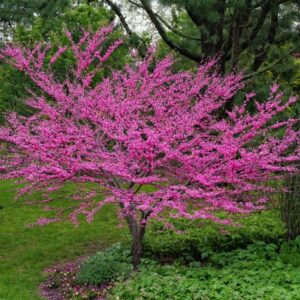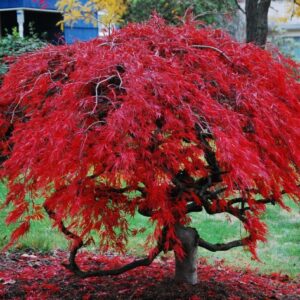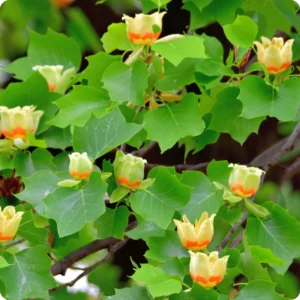Description
Honeyberry Tree – 1 Yr Old Seedling
Overview
The Honeyberry Tree (Lonicera caerulea) is a cold-hardy shrub known for its early harvest of sweet, berry-like fruits that resemble blueberries but with a more tangy and aromatic flavor. Also called haskap, this shrub thrives in colder climates, making it an excellent choice for northern gardeners looking for a unique and early-season fruit. Honeyberries are not only tasty but also nutritious, packed with antioxidants and vitamins. This plant is a perfect addition to edible landscapes, offering both beauty and bounty.
Honeyberry Tree Native Range
Native to northern Asia, Europe, and North America, particularly in regions with colder climates, such as Siberia and parts of Canada.
Growth and Form
- Height: Grows to 3–6 feet at maturity.
- Spread: Typically spreads 3–5 feet.
- Growth Rate: Moderate growth, with fruit production starting in 2–3 years.
- Foliage: Oval, dark green leaves that turn yellow in the fall.
- Flowers: Small, pale yellow to white flowers in early spring, before the leaves emerge.
- Fruit: Oblong, blue-purple berries with a sweet, tangy flavor.
Ecological Benefits
- Wildlife Habitat: Flowers attract early-season pollinators like bees, and the fruit provides food for birds.
- Pollinator Support: Cross-pollination between varieties increases fruit yield, benefiting local pollinator populations.
- Edible Landscaping: The attractive flowers and berries make Honeyberry a great option for edible hedgerows or backyard gardens.
Honeyberry Tree Hardiness and Climate Tolerance
- Hardiness Zones: 2–8, making it ideal for cooler climates.
- Cold Tolerance: Extremely cold-hardy, withstanding temperatures as low as -40°F (-40°C).
- Heat Tolerance: Prefers cooler climates but can tolerate some heat with adequate moisture.
- Soil Preferences: Thrives in well-drained, slightly acidic to neutral soils.
Honeyberry Tree Planting and Care
- Planting Location: Best in full sun but tolerates partial shade. Choose a location with well-drained soil and air circulation.
- Watering: Regular watering is essential, especially during dry spells in the first few years.
- Fertilization: Apply a balanced fertilizer in early spring to promote healthy growth and fruiting.
- Pruning: Prune annually to remove dead wood and shape the plant, encouraging better air circulation and fruit production.
Uses
- Culinary: Honeyberries are great for fresh eating, jams, jellies, smoothies, and baking.
- Landscaping: Attractive as an ornamental shrub in edible gardens, hedgerows, or borders.
- Wildlife Support: The berries attract birds and the flowers support early-season pollinators.
Potential Problems
- Diseases: Honeyberries are relatively disease-resistant but may be susceptible to mildew in humid conditions.
- Pests: Aphids and Japanese beetles may occasionally target the plant. Regular monitoring and pest management help keep it healthy.
- Self-Pollination: While some varieties are self-pollinating, planting multiple varieties increases fruit yield.






Reviews
There are no reviews yet.